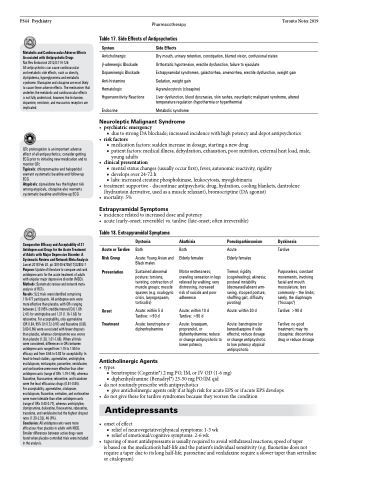Page 1208 - TNFlipTest
P. 1208
PS44 Psychiatry
Pharmacotherapy
Toronto Notes 2019
Table 17. Side Effects of Antipsychotics
Metabolic and Cardiovascular Adverse Effects Associated with Antipsychotic Drugs
Nat Rev Endocrinol 2012;8:114-126
All antipsychotics can cause cardiovascular
and metabolic side effects, such as obesity, dyslipidemia, hyperglycermia and metabolic syndrome. Olanzapine and clozapine are most likely to cause these adverse effects. The mechanism that underlies the metabolic and cardiovascular effects is not fully understood, however, the histamine, dopamine, serotonin, and muscarinic receptors are implicated.
QTc prolongation is an important adverse effect of all antipsychotics; consider getting ECG prior to initiating new medication and to monitor QTc
Typicals: chlorpromazine and haloperidol warrant systematic baseline and follow-up ECG
Atypicals: ziprasidone has the highest risk among atypicals, clozapine also warrants systematic baseline and follow-up ECG
Comparative Efficacy and Acceptability of 21 Antidepressant Drugs for the Acute Treatment of Adults with Major Depressive Disorder: A Systematic Review and Network Meta-Analysis Lancet 2018 Feb 20. pii: S0140-6736(17)32802-7 Purpose: Update of literature to compare and rank antidepressants for the acute treatment of adults with unipolar major depressive disorder (MDD). Methods: Systematic review and network meta- analysis of RCTs.
Results: 522 trials were identified comprising
116 477 participants. All antidepressants were more effective than placebo, with ORs ranging between 2.13 (95% credible interval [CrI] 1.89- 2.41) for amitriptyline and 1.37 (1.16-1.63) for reboxetine. For acceptability, only agomelatine (OR 0.84, 95% CrI 0.72-0.97) and fluoxetine (0.88, 0.80-0.96) were associated with fewer dropouts than placebo, whereas clomipramine was worse than placebo (1.30, 1.01-1.68). When all trials were considered, differences in ORs between antidepressants ranged from 1.15 to 1.55 for efficacy and from 0.64 to 0.83 for acceptability. In head-to-head studies, agomelatine, amitriptyline, escitalopram, mirtazapine, paroxetine, venlafaxine, and vortioxetine were more effective than other antidepressants (range of ORs 1.19-1.96), whereas fluoxetine, fluvoxamine, reboxetine, and trazodone were the least efficacious drugs (0.51-0.84).
For acceptability, agomelatine, citalopram, escitalopram, fluoxetine, sertraline, and vortioxetine were more tolerable than other antidepressants (range of ORs 0.43-0.77), whereas amitriptyline, clomipramine, duloxetine, fluvoxamine, reboxetine, trazodone, and venlafaxine had the highest dropout rates (1.30-2.32), 46 (9%).
Conclusion: All antidepressants were more efficacious than placebo in adults with MDD. Smaller differences between active drugs were found when placebo-controlled trials were included in the analysis.
System
Anticholinergic β-adrenergic Blockade Dopaminergic Blockade Anti-histamine Hematologic Hypersensitivity Reactions
Endocrine
Side Effects
Dry mouth, urinary retention, constipation, blurred vision, confusional states Orthostatic hypotension, erectile dysfunction, failure to ejaculate
Extrapyramidal syndromes, galactorrhea, amenorrhea, erectile dysfunction, weight gain Sedation, weight gain
Agranulocytosis (clozapine)
Liver dysfunction, blood dyscrasias, skin rashes, neuroleptic malignant syndrome, altered temperature regulation (hypothermia or hyperthermia)
Metabolic syndrome
Neuroleptic Malignant Syndrome
• psychiatricemergency
•
•
•
•
■ due to strong DA blockade; increased incidence with high potency and depot antipsychotics
riskfactors
■ medication factors: sudden increase in dosage, starting a new drug
■ patient factors: medical illness, dehydration, exhaustion, poor nutrition, external heat load, male,
young adults
clinicalpresentation
■ mental status changes (usually occur first), fever, autonomic reactivity, rigidity ■ develops over 24-72 h
■ labs: increased creatine phosphokinase, leukocytosis, myoglobinuria
treatment:supportive-discontinueantipsychoticdrug,hydration,coolingblankets,dantrolene (hydrantoin derivative, used as a muscle relaxant), bromocriptine (DA agonist)
mortality: 5%
Extrapyramidal Symptoms
• incidencerelatedtoincreaseddoseandpotency
• acute(early-onset;reversible)vs.tardive(late-onset;oftenirreversible)
Table 18. Extrapyramidal Symptoms
Acute or Tardive Risk Group
Presentation
Onset Treatment
Dystonia
Both
Acute: Young Asian and Black males
Sustained abnormal posture; torsions, twisting, contraction of muscle groups; muscle spasms (e.g. oculogyric crisis, laryngospasm, torticollis)
Acute: within 5 d Tardive: >90 d
Acute: benztropine or diphenhydramine
Akathisia
Both
Elderly females
Motor restlessness; crawling sensation in legs relieved by walking; very distressing, increased risk of suicide and poor adherence
Acute: within 10 d Tardive: >90 d
Acute: lorazepam, propranolol, or diphenhydramine; reduce or change antipsychotic to lower potency
Pseudoparkinsonism
Acute
Elderly females
Tremor; rigidity (cogwheeling); akinesia; postural instability (decreased/absent arm- swing, stooped posture, shuffling gait, difficulty pivoting)
Acute: within 30 d
Acute: benztropine (or benzodiazepine if side effects); reduce dosage or change antipsychotic to low potency atypical antipsychotic
Dyskinesia
Tardive
Purposeless, constant movements, involving facial and mouth musculature; less commonly – the limbs; rarely, the diaphragm ("hiccups")
Tardive: >90 d
Tardive: no good treatment; may try clozapine; discontinue drug or reduce dosage
Anticholinergic Agents
• types
■ benztropine (Cogentin®) 2 mg PO, IM, or IV OD (1-6 mg)
• •
• •
■ diphenhydramine (Benadryl®) 25-50 mg PO/IM qid donotroutinelyprescribewithantipsychotics
■ give anticholinergic agents only if at high risk for acute EPS or if acute EPS develops donotgivethesefortardivesyndromesbecausetheyworsenthecondition
Antidepressants
onsetofeffect
■ relief of neurovegetative/physical symptoms: 1-3 wk ■ relief of emotional/cognitive symptoms: 2-6 wk
taperingofmostantidepressantsisusuallyrequiredtoavoidwithdrawalreactions;speedoftaper
is based on the medication’s half-life and the patient’s individual sensitivity (e.g. fluoxetine does not require a taper due to its long half-life; paroxetine and venlafaxine require a slower taper than sertraline or citalopram)


